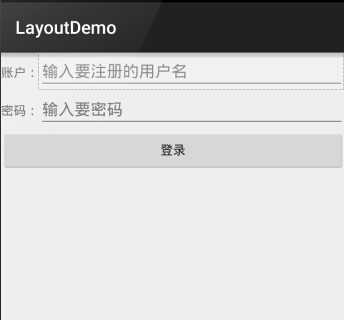标签:
TableLayout运行我们使用表格的方式来排列控件,它的本质依然是线性布局。表格布局采用行、列的形式来管理控件,TableLayout并不需要明确的声明包含多少行多少列,而是通过添加TableRow、其他组件来控制表格的行数和列数。
每次向Table中添加一个TableRow,该TableRow就是一个表格行,TableRow也是容器,因此它也可以不断的添加其他组件,每添加一个子组件该表格就增加一列。
实例代码,实现一下简单的登录界面
tablelayout.xml
<?xml version="1.0" encoding="utf-8"?> <TableLayout xmlns:android="http://schemas.android.com/apk/res/android" android:layout_width="match_parent" android:layout_height="match_parent" android:stretchColumns="1"> <TableRow> <TextView android:layout_height="wrap_content" android:text="账户:"/> <EditText android:id="@+id/usernameInput" android:layout_height="wrap_content" android:hint="输入要注册的用户名"/> </TableRow> <TableRow> <TextView android:layout_height="wrap_content" android:text="密码:"/> <EditText android:id="@+id/passwordInput" android:layout_height="wrap_content" android:hint="输入要密码"/> </TableRow> <TableRow> <Button android:id="@+id/loginButton" android:layout_height="wrap_content" android:layout_span="2" android:text="登录"/> </TableRow> </TableLayout>
显示结果为:

显然,太丑了,我们想要在左右两边都有一定的间距,并且所有组件都位于屏幕中间,这里就需要一些属性来配合达到这些效果。
android:collapseColumns="0"——隐藏第0列
android:shrinkColumns="0"——收缩第0列
android:stretchColumns="0"——拉伸第0列
Android笔记(九) Android中的布局——表格布局
标签:
原文地址:http://www.cnblogs.com/xs104/p/4725973.html